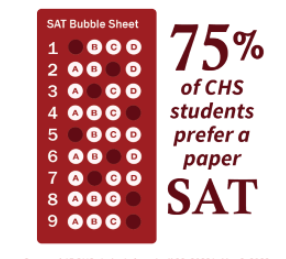College Board’s SAT joins the digital age

BLOT GRAPHICS BY SABRINA Z. LIDING and ZAINA SAIF
Survey of 45 CHS students from April 26,2022 to May 2,2022.
May 20, 2022
The College Board’s SAT joins the world’s shift in going virtual, as the Class of 2024 and 2025 will be the first to take the new, digital version of the exam.
According to the College Board, the digitized SAT will be first administered at international test centers in the spring of 2023 and will then be offered in the U.S. in the spring of 2024. The PSAT/NMSQT, PSAT 10 and PSAT 8/9 will also be online beginning in the fall of 2023.
Once the College Board begins administering the SAT Suite digitally, they will no longer offer a handwritten version of the test. The exam will continue to be taken in schools or test centers, and students will be able to use a personal device, a school-issued one or, if the student does not have access to a device, the College Board will provide one for them to use on the test day.
Going digital also allows the test to be unique for each student, so it would be almost impossible to share answers. Students will get their scores back in a matter of days, alleviating the anxiety many feel prior to finding out their scores. There will also be tools to flag questions in order to come back to them later and a countdown clock to alert students when they’re running out of time.
CHS math teacher Cheryl Vetser focuses on preparing her students for the SAT, and says that the new form of the standardized test will require some learning of her own.
“To help prepare students, I’ll have to become more familiar with the new format and possibly give students more questions electronically,” Vetser said.
With changes to format comes changes to test material as well. The digital SAT will be shorter— roughly two hours instead of three — allowing for more time per question. It will include shorter reading passages with one question attached to each, and the texts will cover a broader range of topics to match what students will likely read in college. Calculators will be permitted throughout the entire math section, eliminating the no-calculator section of the current SAT.
When asked about what she thinks about this new form of the SAT, senior Riley O’Brien of Neptune discussed how the digital SAT may be more comfortable for students to take.
“When you take the paper test it’s kind of out of the ordinary for students, so you subconsciously realize it’s a much bigger deal and that it does count for something big,” O’Brien said. “But if you’re on a computer I think kids would be less nervous about it.” said O’Brien.
However, Junior Danielle Lirov of Marlboro holds a different opinion on how taking a paper test affects the SAT experience.
“Honestly I’m kind of happy that I got to take the paper version of the test because, the way that I prepared, I was pretty good with the paper SAT,” Lirov said. “I think sometimes it’s reliable just having a paper and pencil right in front of you.”
The College Board piloted a virtual version of the SAT in November of 2021 with students around the world and found that 80% of the students preferred the online test to the paper version. These results dramatically differ with the feelings of CHS students, 75% of which reported that they would prefer taking the SAT on paper rather than digitally.
Nevertheless, Freshman Kylie Budiongan of Marlboro is excited about the changes that will be made to the SAT by the time she is a junior.
“I think since a lot of us grew up with technology, the digital SAT will be more accommodating,” Budiongan said.
The digital SAT may also encourage more students to submit their scores to colleges. The College Board reports that 83% of students say they still want the option to submit scores in their college applications. Although over 1,800 schools did not require an SAT score submission in the 2022 admissions cycle, scores are generally known to help students demonstrate their strengths, and the digital version may allow them to better do so.
The College Board stresses that the overall intent of converting the SAT to a digital forum is to make it more student-friendly.
“We’re not simply putting the current SAT on a digital platform—we’re taking full advantage of what delivering an assessment digitally makes possible,” said Priscilla Rodriguez, Vice President of College Readiness Assessments at College Board.





